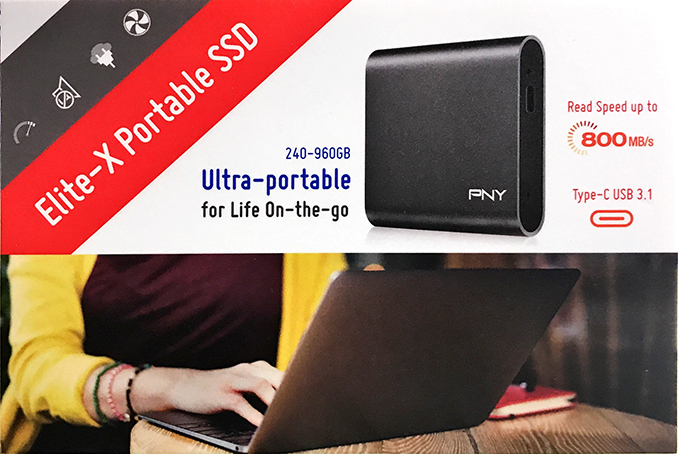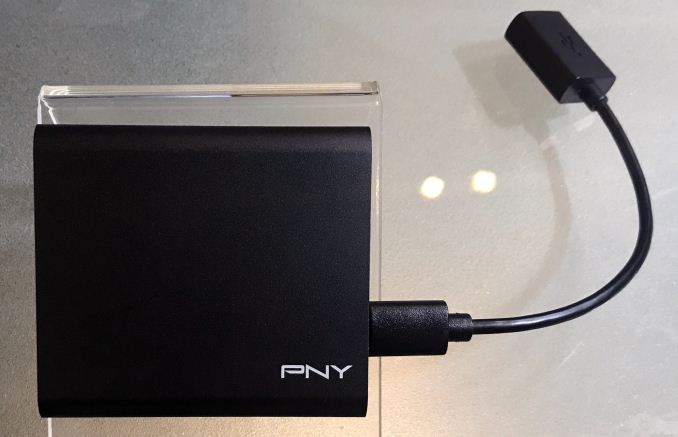PNY Preps External Elite-X Portable SSD with USB-C 3.1 Interface: Up to 800 MB/s
by Anton Shilov on June 26, 2018 11:00 AM EST- Posted in
- SSDs
- Storage
- Trade Shows
- PNY
- Computex 2018
- Elite-X Portable SSD

PNY demonstrated its new external SSD at Computex earlier this month. The new Elite-X Portable SSD uses a USB 3.1 Gen 2 interface and a USB Type-C connector, thus providing higher performance when compared to the company's existing portable drives.
PNY’s Elite-X Portable SSDs will be available in 240 GB, 480 GB, and 960 GB configurations. The manufacturer specs the drives for up to 800 MB/s sequential read speed, which indicates that there is an SSD with a PCIe 3.0 interface inside that communicates with the host via a PCIe-to-USB bridge (ASMedia’s first-gen bridges could barely hit 10 Gbps). Keeping in mind that PNY specifically chose USB Type-C instead of Thunderbolt to maintain compatibility with Apple’s MacBooks and other ultra-thin laptops with 5 Gbps USB 3.0 connectors, 800 MB/s does not really seem as a major performance bottleneck of the drive.
The manufacturer does not explicitly disclose what drive it uses is inside the Elite-X Portable SSD. Meanwhile considering the fact that PNY works closely with Phison, it is highly likely that the Elite-X Portable SSD uses a Phison PS5008-E8 controller as well as Toshiba’s BICS 3D NAND.
Since the combination of Phison’s PS5008-E8 and Toshiba’s 3D NAND is relatively widespread in the industry, PNY will not have to spend a long time validating the work of the design. Therefore, expect the Elite-X Portable SSDs to hit the market in the coming months. Prices will depend on multiple factors, but expect them to be comparable to the current-generation PNY Elite Portable SSDs: between $90 and $280.
| Want to keep up to date with all of our Computex 2018 Coverage? | ||||||
 Laptops |
 Hardware |
 Chips |
||||
| Follow AnandTech's breaking news here! | ||||||











22 Comments
View All Comments
LordanSS - Tuesday, June 26, 2018 - link
You say that, and it's been a couple years since Intel "opened" the standard on TB3.I ask then, have you seen any products/cards/controllers/etc from anyone else other than Intel? Yeah, I don't think so.
repoman27 - Wednesday, June 27, 2018 - link
Intel only announced plans to make the Thunderbolt protocol specification available to the industry under a nonexclusive, royalty-free license in a press release on May 24, 2017 (so just over a year ago). Also, they merely indicated that this would happen sometime "next year". Given how all other aspects of Intel's roadmap have slipped, I'd assume that this may get pushed out to 2H 2019 as well. I can't imagine that there are any 3rd party semiconductor designs underway yet that include Thunderbolt (except maybe at Apple).Link to press release: https://newsroom.intel.com/editorials/envision-wor...
Fergy - Sunday, July 1, 2018 - link
Thunderbolt is winning the port wars: most laptops/computers don't ship with it. Consoles/smartphones don't ship it. Most laptop docks don't use it. Most ports that support Thunderbolt are used with USB peripherals.imaheadcase - Wednesday, June 27, 2018 - link
USB-C is a love/hate relationship. Sadly %75 i would guess of devices on market don't use it right. I know from experience, i've bought maybe 10 USB-C hubs over the year so far and only 2 work right. By work they are still finicky about working sometimes.They simply can't get power delivery right on them. Even my brand new Dell monitor spent fortune for the USB-C will only sometimes work.
I'm not sure the reason for this, if its lax standards for it when making devices, cheap components, or mixture of both. I suspect its mostly Chinese based products since they pump them out so fast.
By the way, the 10 devices are just the ones that warranty passed on, i've returned half a dozen more..4 from same manufacturer that the USB-C device didnt flat out work. Finally the last attempt i popped out the case to look inside and it was a total mess on circuit board, they had solder splatter all over that if you shake it can hear it rattle inside. They had some sort of hot glue randomly melted in spots. The actual USB-C connection inside was a wired connection to the board inside of solid connection. lol
I never recommend USB-C stuff to people unless its already on motherboard of phone. Even my older motherboard was first to have USB-C on it was disabled via bios update because they could not get it to work via drivers.
HStewart - Tuesday, June 26, 2018 - link
"Keeping in mind that PNY specifically chose USB Type-C instead of Thunderbolt to maintain compatibility with Apple’s MacBooks and other ultra-thin laptops with 5 Gbps USB 3.0 connectors, 800 MB/s does not really seem as a major performance bottleneck of the drive."Thunderbolt 3 is fully compatible with USB-C which has adapters for lower performance USB 3,0 connectors
repoman27 - Wednesday, June 27, 2018 - link
What Anton is trying to say is that because this is a USB 3.1 device, it will work with *any* USB host, including Thunderbolt 3 hosts. Whereas Thunderbolt devices, including Thunderbolt 3, can generally only be used with Thunderbolt hosts.The JHL7440 Titan Ridge Thunderbolt 3 controller (which should be available by now) supposedly offers an optional compatibility mode for connecting to USB Type-C hosts (non-Thunderbolt), but I haven't seen any devices that demonstrate this capability yet.
Intel Titan Ridge press release here: https://thunderbolttechnology.net/blog/new-intel&#...™-3-controllers-offer-displayport-14-and-basic-peripheral-compatibility-u
(Ugh. That URL contains both a ® and a ™, so I'm guessing it will get mangled as soon as I hit "Submit Comment" and can no longer edit this post.)
HStewart - Wednesday, June 27, 2018 - link
What I saying is there devices out that support both TB 3 and USB-C - but it very possible that supporting both means that you don't get the full speed of TB 3 - I did see drives that only support TB 3 that ran 2400MB instead 400 or so.repoman27 - Wednesday, June 27, 2018 - link
Right, WDC has the G-DRIVE and G-RAID with Thunderbolt 3, and Seagate offers the LaCie Rugged, d2 and big Thunderbolt 3 drives with dual interfaces. However, I believe those devices are implemented using a USB to SATA bridge chip connected to the basic USB Type-C port, a PCIe SATA host controller connected to the Thunderbolt controller, and a SATA 6Gbps 2:1 mux plus a microcontroller to switch between whichever port is in use and the SATA device or RAID controller. Which ends up being both complicated and expensive.There is essentially no practical scenario where SuperSpeed USB 10Gbps limits the performance of even a pair of SATA 6Gbps drives in RAID 0. So the added expense of these dual Thunderbolt 3 / USB 3.x Type-C designs is pointless except for corner cases where you want to support the maximum transfer rates when using a $49 dongle with hosts that have Thunderbolt or Thunderbolt 2 interfaces and lack USB 3.x. It's really only for RAID arrays with more than two drives that this begins to make any sense at all.
repoman27 - Wednesday, June 27, 2018 - link
To clarify, while all Thunderbolt 3 ports support native USB 3.1 Gen 2 signaling as downstream facing ports (host ports), the JHL7440 is the only controller that supports operation as an upstream facing port (device port). The dual-interface designs currently on the market have 1 or 2 Thunderbolt 3 ports in addition to a separate USB 3.x Type-C port, and only one interface can be used at a time. Much like the multi-interface USB / FireWire / eSATA drives of yore.repoman27 - Wednesday, June 27, 2018 - link
"The manufacturer specs the drives for up to 800 MB/s sequential read speed, which indicates that there is an SSD a PCIe 3.0 interface inside that communicates with the host via a PCIe-to-USB bridge (ASMedia’s first-gen bridges could barely hit 10 Gbps)."I think you missed a preposition, probably "with" in that sentence.
But also, it indicates no such thing. This is almost certainly just two SATA SSDs in RAID 0 behind an ASM1352R (SuperSpeed USB 10Gbps to dual SATA 6Gbps bridge chip). I have an enclosure with that chip that was released back in 2015, and I've clocked it at over 900 MB/s sequential read / 850 MB/s sequential write with a pair of 500 GB Samsung SSD 850 EVOs in it.
And your parenthetical comment is odd, considering USB 3.1 Gen 2, a.k.a. SuperSpeed USB 10Gbps, is very clearly limited to 10 Gbit/s, before you even account for encoding and protocol overhead. In other words, device throughput numbers will necessarily be less than 10 Gbit/s, so even barely hitting that would be impossible. By my calculations, real world throughput should top out in the 8360 - 8520 Gbit/s (1045 - 1065 MB/s) range.